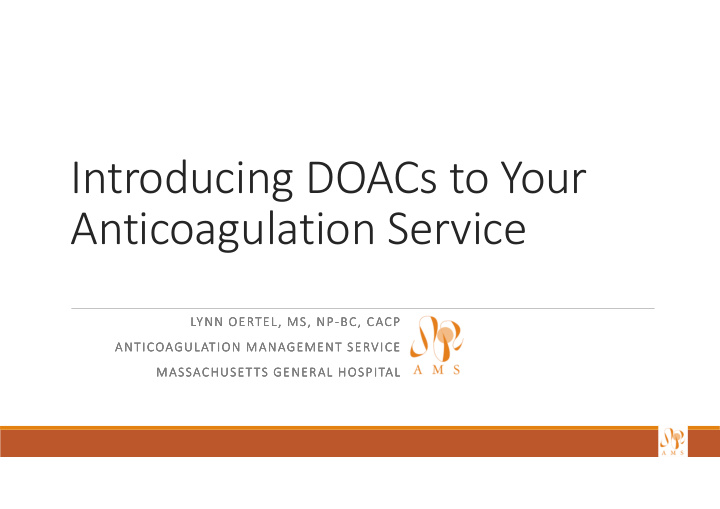



Introducing DOACs to Your Anticoagulation Service LYNN OERTEL, MS, NP LYNN OERTEL, MS, NP LYNN OERTEL, MS, NP LYNN OERTEL, MS, NP- - - -BC, CACP BC, CACP BC, CACP BC, CACP ANTICOAGULATION MANAGEMENT SERVICE ANTICOAGULATION MANAGEMENT SERVICE ANTICOAGULATION MANAGEMENT SERVICE ANTICOAGULATION MANAGEMENT SERVICE MASSACHUSETTS GENERAL HOSPITAL MASSACHUSETTS GENERAL HOSPITAL MASSACHUSETTS GENERAL HOSPITAL MASSACHUSETTS GENERAL HOSPITAL
Challenges at the start…. � Consensus / agreement among stakeholders that this is the ‘right thing’ to do � Technical changes related to DOAC modules and hospital systems � Staff hesitancy – ‘already busy enough’ � Knowledge gaps and need for staff education � No quality examples of ‘how to do’ this
DOAC vs. warfarin within Loyal Cohort* *Loyal Cohort = patients receiving primary care at MGH Source: MGH Fireman Vascular Center
Clinical staff education curriculum Blended learning experience Credit hours awarded (5.66 from Knight Center and 1 from online program)
Required reading assignments RUFF CT ET AL. THE AMERICAN JOURNAL OF BURNETT AE ET AL. J THROMB MEDICINE (2016) 129, S1-S29 THROMBOLYSIS (2016) 41:206–232
Identify knowledge gaps and needs 120 Pre-assessment results Pre and Post knowledge assessments (AMS staff GOAL 100 required to achieve 100% on post test) 80 ◦ 23 multiple-choice items ◦ Post-assessment “open book” 60 score 40 20 0 1 2 3 4 5 6 7 8 9 10 11 12 13 14 15 16 17
DOAC Referral Cascading options presented according to: ◦ Indication ◦ Drug/dose options ◦ Transitioning, if applicable ◦ Off label use statement RN staff worksheet to confirm eligibility
Standard Follow-up Plan
DOAC List view Date filter = Today Televox automated calls made 2 days prior to patient’s scheduled QNR F/U date ◦ Patient’s response used to indicate confirmation of availability F/U QNRs average 5-10 minutes
Patient and Family Education Slideshow Caveats: MGH experience thus • far with warfarin patients transitioning to a DOAC Education by phone • (packet mailed in advance) Average time on phone • ~ 22 minutes
Updated Medication Guides Find in: Partners Handbook or EED anticoag portal page Spanish translations available. English and Spanish MGH Instructions can be accessed in Epic.
Revision of existing Patient Agreement to incorporate DOACs
DOACs At-a-Glance Reference
DOAC POTENTIAL interacting drugs
Follow-up QNRs: A broader assessment of patient is needed and includes adherence and medication changes (as noted in QNR) but also: Dawn F/U QNRs: ◦ Hospitalized/ED visit for what reason and when ◦ Adherence* – use 80% rule ◦ Interruption in DOAC therapy (and details) that AMS unaware of? ◦ Medication surveillance for potentially interacting meds* that may require dose ◦ Seen by MD other than ‘well’ visits adjustment or avoid use ◦ Any side effects? (assess if bruising increased on DOAC when compared with warfarin experience) Dawn Lab QNRs*: ◦ eGFR, Creatinine and Hct obtained per Standard ◦ Verification of change in dose as expected (for new VTE F/U plan (manual process now, future: via lab type indications only: Apix on Day 8 of trt and Riva on Day interface) 22 of Trt) ◦ Check on refills provided with initial Rx – how many Adverse events – documented in Events Tab refills? Procedures – documented in Procedures Tab ◦ Issues with drug procurement/financial concerns about getting refills as needed? Above assessment captured and documented in Epic Tel * - This information displayed in AMS icon via Outbound Encounter Interface message along with next scheduled F/U date
How do I make an assessment of DOAC adherence?
Adherence (mark as non-adherent) • Adherence “reflects the manner in which patients take their medications relative to the agreed regimen with the prescriber” (NICE, 2009) • Considered adherent if “take medication as prescribed more than 80% of the time” (WHO, .dadNO = During today's follow-up, patient reports missing _ 2003) doses over past _____. Importance of not missing any doses was reinforced and interventions explored to improve adherence. Based on adherence concerns, follow-up in 1 month.. .dadYES = During a phone call follow-up today, patient accurately described dose and adherence with taking as prescribed.
AMS DOAC Icon
Pilot evaluation to demonstrate value to organization � Adherence (patient reported) � Renal Function or drop in Hct necessitating a dose change or avoid use � Identification of Drug Interactions which may require a change in therapy � Adverse events � Optimal management of transitions/interruptions in care � Patient experience
Recommend
More recommend